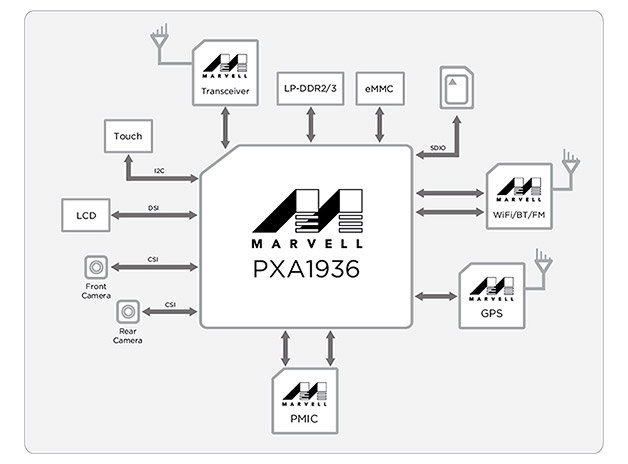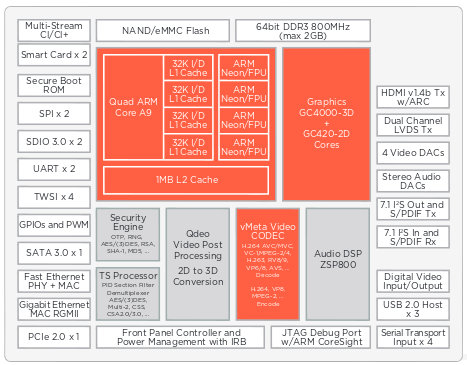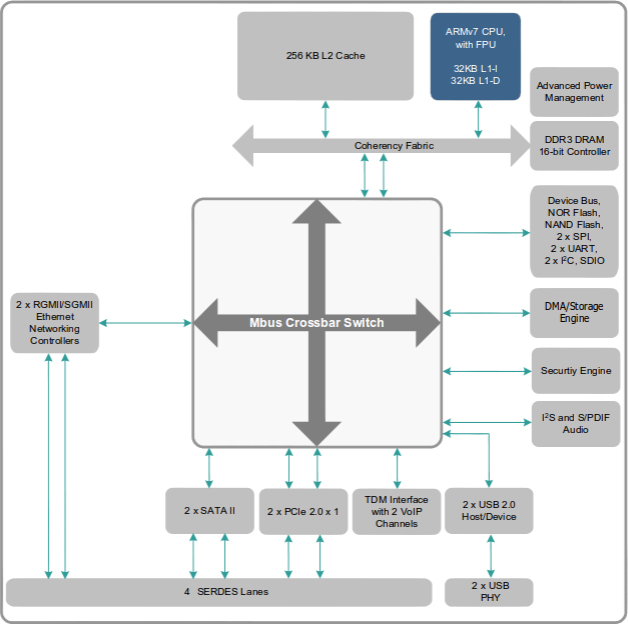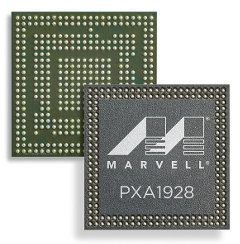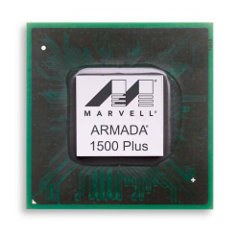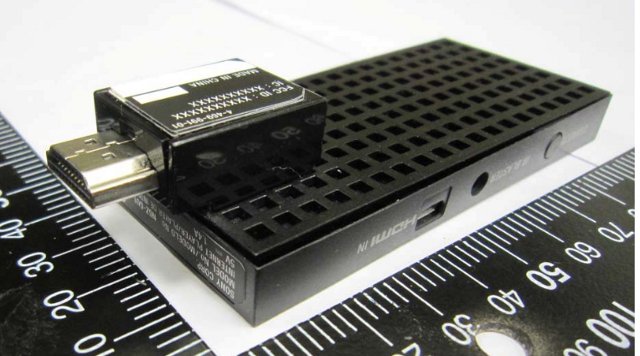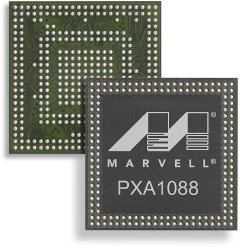Marvell announced ARMADA PXA1928 quad core Cortex A53 LTE SoC at the beginning of the year, and they’ve now introduced two new Cortex A53 based processors with PXA1936 and PXA1908, featuring respectively eight and four ARM Cortex A53 cores at 1.5 GHz, and 5-mode 4G LTE support (TD-LTE, FDD-LTE, TD-SCDMA, WCDMA and GSM). PXA1936 targets high performance smartphones and tablets, whereas PXA1908 targets mid-range / mainstream mobile devices. Key features of the Marvell ARMADA Mobile PXA1936 include: Octa core Cortex A53 up to 1.5GHz Supports 1080p display, and video encoding and decoding Improved image processor to support 13 to 16MP camera Advanced power management and audio codec for power efficiency and audio performance Enhanced security processor Integrated location and sensor hub functionalities for better usability Field proven DSDS (Dual Sim Dual Standby) software for 5-mode modem While key features of Marvell ARMADA Mobile PXA1908 include: Cost optimized quad-core Cortex A53 […]
Marvell Announces Quad Core ARMADA 1500 PRO 4K STB SoC with HEVC 10-Bit Support
Marvell has just announced a new member of its ARMADA 1500 family of multimedia processors with ARMADA 1500 PRO 4K (88DE3214), a quad-core ARM processor (12K DMIPS), with a Vivante GC3000 GPU, and Qdeo video processor supporting 4K (UHD) output and HEVC 10-bit codec. These processors will be used in smart TVs, set-top boxes (STB), over-the-top (OTT) boxes, thin-client devices, etc.. Details are scarce, but ARMADA 1500 PRO 4K could be an evolution of the ARMADA 1500 PRO processors with four Cortex A9 cores as shown above, but with a different GPU, 4K and HEVC support, and possibly some extra features for DRM. The key features mentioned by the company are as follows: 3840×2160 (UHD) at 60 frames per second 10 bit HEVC Video Decode Up to 12K DMIPs Quad Core ARM CPU Multi-core GPU, 8 shader Vivante GC3000 GPU Robust Security Engine – Security features include Trusted Rendering Path […]
Marvell Armada 370 Processor Datasheet Released, Mainline Linux Kernel Supported on Netgear ReadyNAS 102/104
Free Electrons has been working on porting several ARM SoC to the Linux kernel (mainline), including Marvell XP and 370 SoCs, and they’ve been informed by Marvell that the company finally released Marvell Armada 370 processor publicly without requiring NDA nor registration. Marvell Armada XP dual and quad core processors datasheet found in higher-end NAS and cloud servers has not been released (yet), but we’ve been told many peripheral blocks are very similar, so Marvell Armada 370 datasheet can also be used for Armada XP processors to some extend. Two documents have actually been released for Marvell Armada 370: the functional specification and the hardware specification (datasheet). The first document is actually the one with the most information with 1148 pages providing details about peripherals, against 164 pages for the latter providing details about pins and electrical characteristics. So we’ve got an ARM SoC with mainline kernel support, and decent […]
Marvell ARMADA Mobile PXA1928 SoC Features Four Cortex A53 Cores, Vivante GC5000 GPU, and LTE
So here we are with another 64-bit ARM SoC for mobile device thanks to Marvell ARMADA Mobile PXA1928 with four ARM Cortex A53 cores, Vivante GC5000 GPU, and a 5-mode modem with LTE TDD/FDD, HSPA+, TD-HSPA+, and EDGE. The SoC will be used in conjunction with the company’s Avastar 88W8887 802.11ac Wi-Fi + Bluetooth 4.0 + FM + Near Field Communication (NFC) single chip solution, as well as 88L2000 Global Navigation Satellite System (GNSS) hybrid location processor, and the new 88NV1088 eMMC 5.0 NAND Flash controller. Key features of Marvell ARMADA Mobile PXA1928 include: 5-Mode Cellular Modem Solution for LTE Cat 4, UMTS Release 7, TD-HSPA+ Release 8, and class 12 GSM/EDGE, and supports multi-radio, CSFB, and VoLTE voice solutions for LTE networks 3G/4G protocol stacks certified on major carrier networks and validated via extensive IOT, GCF and field trial testing Quad-core ARM Cortex A53MP Application Processor Subsystem Support for […]
Marvell Unveils ARMADA 1500 Plus (88DE3108) SoC for Android and Linux Smart Video Platforms
Building on top of it ARMADA 1500 SoC for Google TV, Marvell has recently announced the ARMADA 1500 Plus (88DE3108) HD secure media processor SoCdesigned for smart video products based on Android 4.2.2, and Linux, such as media players, OTT boxes, hybrid set-top boxes and smart TVs. ARMADA 1500 Plus features two ARM Cortex A9 cores, Vivante GC1000 and GC300 GPUs, respectively for 3D and 2D graphics, and integrates an HDMI receiver and Gigabit Ethernet. Hisense will be among the first to use the platform with the upcoming H6 Smart TV and Pulse Pro set-top-box, but details have yet to be released for these two products. Here are the key features of 88DE3108 SoC: Processor – Dual core Cortex A9 with over 6000 Dhrystone MIPS Dedicated 3D and 2D graphics acceleration – dual threaded unified shader (Vivante GC1000 and GC300) with support for OpenGL ES 1.1/2.0 and DirectFB. Video vMeta […]
NSZ-GU1, Sony’s Next Google TV Box will be an HDMI TV Stick
Since 2010, Sony has been working on Google TV device, and last year they announced Sony NSZ-GS7, a Google TV 2.0 set-top box. This year, nothing have been announced yet, but a few pictures of a new device have shown up in the FCC site. Sony NSZ-GU1 will be some sort of HDMI TV stick that you insert into your TV, except it looks more like a small set-top box has been glued onto an HDMI TV dongle. Here are the specifications derived from the FCC fillings and pictures: SoC- Marvel 88DE3108-A1 dual core processor (Marvell Armada 1500). System Memory – 1GB RAM Storage – 4GB NAND Flash (Toshiba THGBM5G5, If I’ve read correctly) Video I/O – HDMI output (MHL) 720p/60, micro HDMI input 720p/60 Connectivity – 802.11b/g/n WiFi (AzureWave AW-NH390), Bluetooth 3.0 USB – 1x micro USB port (for power only?) Misc – IR Blaster Power – 5V via […]
Zyxel NSA310 / NSA320 Hackable Network Access Storages Run Debian Linux
Yesterday, we saw how to make a NAS enclosure for the Cubieboard, but DesertF0x commented “Better take a NSA-310 or NSA-320. It is easy to install Debian and it has Gigabit!”, and I decided to have a look. The 2 devices appear to have been released at the end of 2011, and are powered by a Marvell ARMv5 compatible processor. Many NAS are expensive kits, but NSA310 (1 bay) is currently available for $88.50 and NSA320 (2 bays) for $95.34 on Amazon, which is just a little cheaper than the DIY Cubieboard NAS solution (~100 USD). Price looks attractive, now let’s have a look at some technical details, and instructions to install Debian. Both NAS more or less share the same hardware specifications except for a few details: Processor – Marvell Kirkwood 88f6281 ARMV5-TE compliant processor @ 1.2 GHz (Hardware datasheet) System Memory – 256 MB (NAS310) or 512 MB […]
Marvell PXA1088 Quad Core Cortex A7 SoC
Marvell has just announced the MarvellPXA1088, a quad-core Cortex A7 application and communications mobile SoC that integrates Marvell’s WCDMA and TD-SCDMA modem technology to provide a low-cost 3G platform for both smartphones and tablets. Marvell’s mobile platform also includes Avastar 88W8777 WLAN + Bluetooth 4.0 + FM single-chip SoC, L2000 GNSS Hybrid Location Processor, and an integrated power management and audio codec IC. PXA1088 is said to be pin-to-pin compatible with the earlier PXA988/PXA986 solutions (dual core SoC) so that current mobile device designs can be upgraded with a quad-core SoC without additional development costs. Additional PXA1088 Features: Support for advanced WCDMA Release 7, TD-SCDMA HSPA+ Release 8, and class 12 EDGE 3G protocol stack certified on all major carrier networks and validated via IOT, GCF and field trail testing Support for popular full-feature operating systems (Including Android 4.2), and industry-standard development tools Multi-radio platform capabilities with WLAN/Bluetooth solutions Integrated […]


